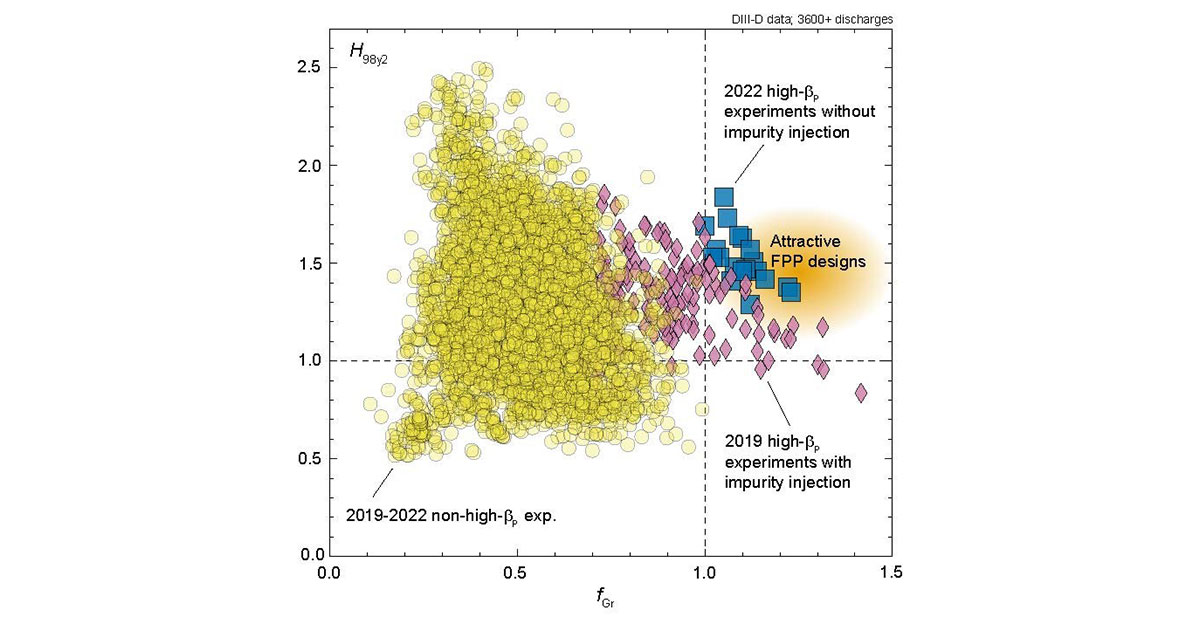
General Atomics Scientists Achieve Key Requirement for Economic Fusion Energy
Experiments at DIII-D National Fusion Facility achieve critical combination of plasma confinement and density required by many fusion power plant designs
San Diego, June 18 – A team led by scientists from General Atomics (GA) has demonstrated, for the first time, an operational approach that is key to many tokamak-based fusion power plant (FPP) designs aiming to generate economically attractive electricity.
The experiments at the DIII-D National Fusion Facility achieved a combination of high density and high confinement of the fuel that had never previously been achieved simultaneously. The results were published in an article in Nature in late April.
“This is a landmark result,” said Dr. Siye Ding, the GA scientist who led the team. “For the first time, we’ve been able to demonstrate a model operational scenario that could be employed by fusion power plants seeking to achieve economically viable electricity generation.”
Advancing the Tokamak Approach to Fusion Energy
The tokamak approach is considered by most experts to be the most mature and promising method of generating fusion energy. Tokamak-based FPPs will use powerful magnetic fields to confine a fuel gas composed of hydrogen isotopes in a high-temperature state known as a plasma. Delivering economically attractive fusion energy will require these tokamaks to maintain very high density and plasma confinement better than a current approach known as “high-confinement mode” (H-mode).
The DIII-D National Fusion Facility is the largest research tokamak in the United States. It is operated by GA on behalf of the DOE’s Office of Science as a user facility for the U.S. fusion research program. As a world-class laboratory, over 700 researchers from more than 100 domestic and international institutions use DIII-D to explore a wide range of topics from fundamental plasma science to FPP operations.
Scientists have been able to create fusion in tokamaks for decades. However, to produce economically attractive electricity, FPPs will need to perform at substantially higher efficiencies than current tokamaks can manage. Two key elements of this are the confinement quality and the density of the plasma that a tokamak is able to maintain during operation.
Confinement quality is best understood as the ability of a tokamak to contain the energy of the fuel at specific conditions long enough to generate a sufficient level of fusion power. High confinement quality requires a low degree of turbulence in the plasma because turbulence allows heat to escape the magnetic fields. Confinement quality is a critical element in the cost-effectiveness of a FPP, because it has a direct impact on the necessary size of the tokamak and other systems of the plant.
H-mode plasmas are viewed as the most promising approach for tokamaks and have been achieved for many years. However, generating enough fusion power to be economically viable requires that the plasma be confined at densities above an empirically defined level, known as the Greenwald Limit.
Breaking Through the “Greenwald Limit”
Previous attempts to reach this point with H-mode plasmas have struggled with high turbulence in the plasma core and instabilities at the edge that disrupt confinement and can potentially damage the tokamak, especially at FPP scale. The need to simultaneously maintain a stable edge and a high-density core – something fusion scientists refer to as “core-edge integration” – is one of the key challenges for fusion energy.
For several years, work at DIII-D has explored methods to suppress turbulence and instabilities while achieving high density and confinement quality. During an experimental campaign in 2022, researchers developed an approach in which the plasma can stabilize itself into a magnetic configuration that achieves both conditions.
This approach exploits a configuration known as “high-poloidal beta” to create plasmas with densities that increase rapidly from the edge to the core. The steep density profile helps suppress core turbulence and enables the high density in the center of the plasma that is necessary for fusion power.
The experiments on DIII-D achieved densities 20 percent above the Greenwald Limit and confinement quality 50 percent better than standard H-mode – the first time any fusion plasma at any facility has reached these heights simultaneously. They also exhibited a stable plasma edge, pointing to a potential solution to the core-edge integration challenge.
“This work supports critical requirements in fusion reactor designs all over the world,” Dr. Ding said. “The physics we’ve demonstrated with these experiments can be extrapolated to full-scale FPPs via integrated modeling, indicating a path toward economic fusion energy.”
Accelerating Clean Fusion Energy
Fusion is the process that powers the stars, and it offers the potential for nearly limitless clean, safe, and carbon-free electricity. As a sustainable, high-output, and dispatchable energy source, fusion would put the U.S. on a path to energy independence and transform the global energy landscape.
As demand for energy grows, fusion is one of the best options for meeting the world’s clean energy needs around the clock while reducing emissions and growing the economy. Developing commercially scalable fusion would ensure energy security while meeting important environmental goals and delivering trillions of dollars in economic benefits.
“These results are really exciting and demonstrate a real roadmap for operating a tokamak in a way that is consistent with the needs of a fusion pilot plant,” added Dr. Wayne Solomon, Vice President of Magnetic Fusion Energy at General Atomics. “The next step is to build on the successes of these experiments by continuing to close remaining scientific gaps as we look ahead to bringing fusion energy to the grid.”
About General Atomics: Since the dawn of the atomic age, General Atomics innovations have advanced the state of the art across the full spectrum of science and technology – from nuclear energy and defense to medicine and high-performance computing. Behind a talented global team of scientists, engineers, and professionals, GA’s unique experience and capabilities continue to deliver safe, sustainable, economical, and innovative solutions to meet growing global demands.
For more information contact:
Evan Polisar
Director of Public Affairs
858-455-3474
Evan.Polisar@ga.com